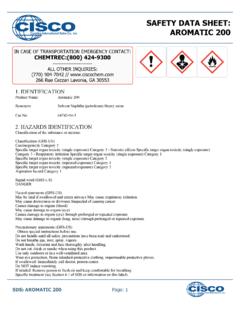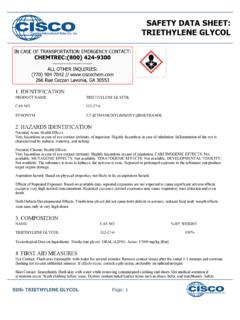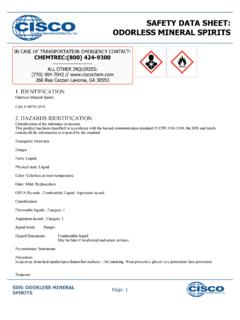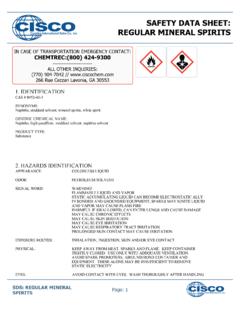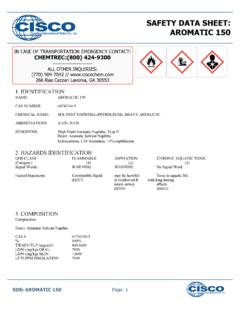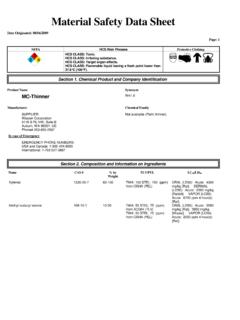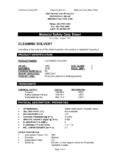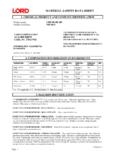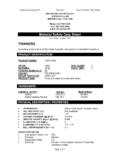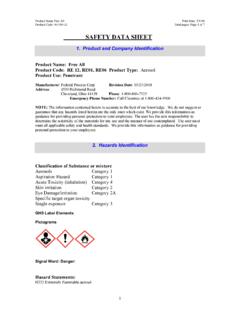Transcription of SAFETY DATA SHEET: METHYL AMYL ALCOHOL
1 SAFETY data sheet : METHYL amyl ALCOHOL1. IDENTIFICATIONNameMETHYL amyl alcohols ynonymsmethyl amyl ALCOHOL , METHYL isobutyl carbinol, 4 methy 2 amyl ALCOHOL ,1,3 dimethylbutanolCAS#108 11 2EC#203 551 7 Product Usessolvent for dyestuffs, oils, gums, resins, waxes, nitrocellulose & ethylcellulose; also organic synthesis particularly lube oiladditives, froth flotation of ores2. HAZARDS IDENTIFICATION OSHA HAZARDS:FLAMMABLE LIQUID, IRRITANTH ealth HazardsIrritating to respiratory system. Vapors may cause drowsiness and dizziness. May cause moderate irritation to skin. Repeatedexposure may cause skin dryness or cracking.
2 Moderately irritating to and SymptomsRespiratory irritation signs and symptoms may include a temporary burning sensation of the nose and throat, coughing, and/ordifficulty breathing. Skin irritation signs and symptoms may include a burning sensation, redness, swelling, and/or blisters. Eyeirritation signs and symptoms may include a burning sensation, redness, swelling, and/or blurred vision. Other signs and symptomsof central nervous system (CNS) depression may include headache, nausea, and lack of Medical ConditionPre existing medical conditions of the following organ(s) or organ system(s) may be aggravated by exposure to this material:Respiratory system.
3 Central nervous system (CNS). Skin. HazardsFlammable liquid and vapor. Vapors are heavier than air. Vapors may travel across the ground and reach remote ignition sourcescausing a flashback fire CASE OF TRANSPORTATION EMERGENCY CONTACT:CHEMTREC:(800) 424-9300-----------------------ALL OTHER INQUIRIES:(770) 904-7042 // Rue Cezzan Lavonia, GA 30553 Page: 1 SDS: METHYL amyl ALCOHOL3. COMPOSITION Material Formal Name 4 methylpentan 2 olSynonyms1,3 dimethyl 1 butanolMIBCM ethyl amyl AlcoholCAS No. 108 11 2 INDEX 008 00 8 EINECS 551 7 4.
4 FIRST AID MEASURESSKIN: Wash with plenty of water. Remove contaminated clothing and do not reuse until thoroughly : Wash eyes with plenty of water, holding eyelids open. Seek medical assistance promptly if there : Remove from contaminated area promptly. CAUTION: Rescuer must not endanger himself! If breathingstops, administer artificial respiration and seek medical aid : Give plenty of water to dilute product. Do not induce vomiting (NOTE below). Keep victim quiet. If vomitingoccurs, lower victim s head below hips to prevent inhalation of vomited material. Seek medical help inhalation of vomited material may seriously damage the lungs. The danger of this is greater than the risk of poisoningthrough absorption of this relatively low toxicity substance.
5 The stomach should only be emptied under medical supervision, andafter the installation of an airway to protect the FIRE FIGHTING MEASURESC lear fire area of all non emergency HazardsCarbon monoxide may be evolved if incomplete combustion occurs. Will float and can be reignited on surface water. The vapor isheavier than air, spreads along the ground and distant ignition is MediaFoam, water spray or fog. Dry chemical powder, carbon dioxide, sand or earth may be used for small fires only. Do not dischargeextinguishing waters into the aquatic Extinguishing MediaDo not use water in a Equipment for FirefightersWear full protective clothing and self contained breathing AdviseKeep adjacent containers cool by spraying with water6.
6 ACCIDENTAL RELEASE MEASURESO bserve all relevant local and international : 2 SDS: METHYL amyl ALCOHOLP rotective measuresAvoid contact with spilled or released material. Immediately remove all contaminated clothing. For guidance on selection ofpersonal protective equipment see Chapter 8 of this Material SAFETY data sheet . For guidance on disposal of spilled material seeChapter 13 of this Material SAFETY data sheet . Shut off leaks, if possible without personal risks. Remove all possible sources ofignition in the surrounding area. Use appropriate containment (of product and fire fighting water) to avoid environmentalcontamination. Prevent from spreading or entering drains, ditches or rivers by using sand, earth, or other appropriate to disperse the vapor or to direct its flow to a safe location for example by using fog sprays.
7 Take precautionary measuresagainst static discharge. Ensure electrical continuity by bonding and grounding (earthing) all equipment. Monitor area withcombustible gas Up MethodsFor large liquid spills (> 1 drum), transfer by mechanical meanssuch as vacuum truck to a salvage tank for recovery or safe disposal. Do not flush away residues with water. Retain as contaminatedwaste. Allow residues to evaporate or soak up with an appropriate absorbent material and dispose of safely. Remove contaminatedsoil and dispose of small liquid spills (< 1 drum), transfer by mechanical means to a labeled, sealable container for product recovery or safedisposal. Allow residues to evaporate or soak up with an appropriate absorbent material and dispose of safely.
8 Remove contaminatedsoil and dispose of AdviceSee Chapter 13 for information on disposal. Notify authorities if any exposure to the general public or the environment occurs or islikely to occur. Vapor may form an explosive mixture with HANDLING AND STORAGEG eneral PrecautionsAvoid breathing vapors or contact with material. Only use in well ventilated areas. Wash thoroughly after handling. For guidance onselection of personal protective equipment see Chapter 8 of this Material SAFETY data sheet . Use the information in this data sheet asinput to a risk assessment of local circumstances to help determine appropriate controls for safe handling, storage and disposal of charges may be generated during pumping.
9 Electrostatic discharge may cause fire. Ensure electrical continuity bybonding and grounding (earthing) all equipment. Restrict line velocity during pumping in order to avoid generation of electrostaticdischarge (<= 10 m/sec). Avoid splash filling. Do NOT use compressed air for filling, discharging, or handling any naked flames. Do not smoke. Remove ignition sources. Avoid sparks. Handling Temperature: away from aerosols, flammables, oxidizing agents, corrosives and from products harmful or toxic to man or to theenvironment. Must be stored in a well ventilated area, away from sunlight, ignition sources and other sources of heat. StorageTemperature: TransferKeep containers closed when not in use.
10 Do not use compressed air for filling, discharging or MaterialsFor container paints, use epoxy paint, zinc silicate paint. For containers, or container linings use mild MaterialsAluminum if > 50 C. Most AdviceContainers, even those that have been emptied, can contain explosive vapors. Do not cut, drill, grind, weld or performsimilar operations on or near InformationEnsure that all local regulations regarding handling and storage facilities are EXPOSURE CONTROLS AND PERSONAL PROECTIONM aterialSource Typeppm mg/m3 NotationPage: 3 SDS: METHYL amyl ALCOHOLM ethyl isobutyl CarbinolACGIHTWA25 ppmACGIHSTEL40 ppmACGIHSKIN_DEScan be absorbedthrough the skinAdditional InformationSkin notation means that significant exposure can also occur by absorption of liquid through the skin and of vapor through the eyesor mucous membranes.
